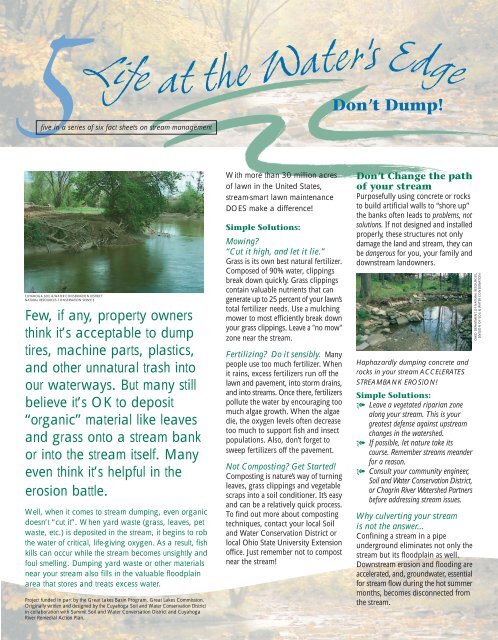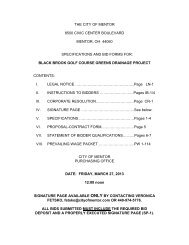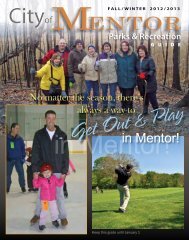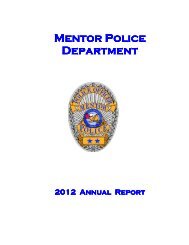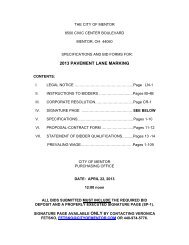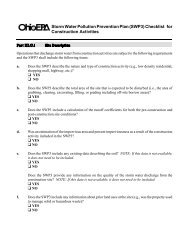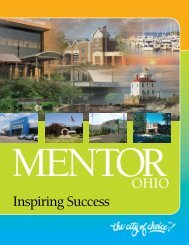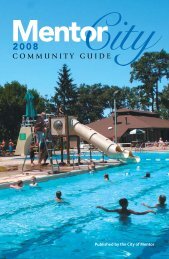Don't Dump! - Chagrin River Watershed Partners
Don't Dump! - Chagrin River Watershed Partners
Don't Dump! - Chagrin River Watershed Partners
You also want an ePaper? Increase the reach of your titles
YUMPU automatically turns print PDFs into web optimized ePapers that Google loves.
five in a series of six fact sheets on stream management<br />
CUYAHOGA SOIL & WATER CONSERVATION DISTRICT<br />
NATURAL RESOURCES CONSERVATION SERVICE<br />
Few, if any, property owners<br />
think it’s acceptable to dump<br />
tires, machine parts, plastics,<br />
and other unnatural trash into<br />
our waterways. But many still<br />
believe it’s OK to deposit<br />
“organic” material like leaves<br />
and grass onto a stream bank<br />
or into the stream itself. Many<br />
even think it’s helpful in the<br />
erosion battle.<br />
Well, when it comes to stream dumping, even organic<br />
doesn’t “cut it”. When yard waste (grass, leaves, pet<br />
waste, etc.) is deposited in the stream, it begins to rob<br />
the water of critical, life-giving oxygen. As a result, fish<br />
kills can occur while the stream becomes unsightly and<br />
foul smelling. <strong>Dump</strong>ing yard waste or other materials<br />
near your stream also fills in the valuable floodplain<br />
area that stores and treats excess water.<br />
Project funded in part by the Great Lakes Basin Program, Great Lakes Commission.<br />
Originally written and designed by the Cuyahoga Soil and Water Conservation District<br />
in collaboration with Summit Soil and Water Conversation District and Cuyahoga<br />
<strong>River</strong> Remedial Action Plan.<br />
With more than 30 million acres<br />
of lawn in the United States,<br />
stream-smart lawn maintenance<br />
DOES make a difference!<br />
Simple Solutions:<br />
Mowing?<br />
“Cut it high, and let it lie.”<br />
Grass is its own best natural fertilizer.<br />
Composed of 90% water, clippings<br />
break down quickly. Grass clippings<br />
contain valuable nutrients that can<br />
generate up to 25 percent of your lawn’s<br />
total fertilizer needs. Use a mulching<br />
mower to most efficiently break down<br />
your grass clippings. Leave a "no mow"<br />
zone near the stream.<br />
Fertilizing? Do it sensibly. Many<br />
people use too much fertilizer. When<br />
it rains, excess fertilizers run off the<br />
lawn and pavement, into storm drains,<br />
and into streams. Once there, fertilizers<br />
pollute the water by encouraging too<br />
much algae growth. When the algae<br />
die, the oxygen levels often decrease<br />
too much to support fish and insect<br />
populations. Also, don’t forget to<br />
sweep fertilizers off the pavement.<br />
Not Composting? Get Started!<br />
Composting is nature’s way of turning<br />
leaves, grass clippings and vegetable<br />
scraps into a soil conditioner. It’s easy<br />
and can be a relatively quick process.<br />
To find out more about composting<br />
techniques, contact your local Soil<br />
and Water Conservation District or<br />
local Ohio State University Extension<br />
office. Just remember not to compost<br />
near the stream!<br />
Don’t <strong>Dump</strong>!<br />
Don’t Change the path<br />
of your stream<br />
Purposefully using concrete or rocks<br />
to build artificial walls to “shore up”<br />
the banks often leads to problems, not<br />
solutions. If not designed and installed<br />
properly, these structures not only<br />
damage the land and stream, they can<br />
be dangerous for you, your family and<br />
downstream landowners.<br />
Haphazardly dumping concrete and<br />
rocks in your stream ACCELERATES<br />
STREAMBANK EROSION!<br />
Simple Solutions:<br />
Leave a vegetated riparian zone<br />
along your stream. This is your<br />
greatest defense against upstream<br />
changes in the watershed.<br />
If possible, let nature take its<br />
course. Remember streams meander<br />
for a reason.<br />
Consult your community engineer,<br />
Soil and Water Conservation District,<br />
or <strong>Chagrin</strong> <strong>River</strong> <strong>Watershed</strong> <strong>Partners</strong><br />
before addressing stream issues.<br />
Why culverting your stream<br />
is not the answer...<br />
Confining a stream in a pipe<br />
underground eliminates not only the<br />
stream but its floodplain as well.<br />
Downstream erosion and flooding are<br />
accelerated, and, groundwater, essential<br />
for stream flow during the hot summer<br />
months, becomes disconnected from<br />
the stream.<br />
OHIO DEPARTMENT OF NATURAL RESOURCES,<br />
DIVISION OF SOIL & WATER CONSERVATION
Water and Wildlife<br />
A fresh water source is critical to wildlife.<br />
Consider installing a small pond or birdbath<br />
to provide essential habitat for birds, insects<br />
and amphibians.<br />
Don’t <strong>Dump</strong>!<br />
ODNR<br />
Get a toad<br />
or two! Toads<br />
are great<br />
insect-eaters<br />
consuming three times their weight in garden<br />
pests each day. Prey includes slugs<br />
(a favorite!), beetles, cutworms, flies,<br />
grasshoppers, gypsy moths, sow bugs, pill<br />
bugs, centipedes, millipedes, mole crickets,<br />
and ants. They won’t harm your flowers or<br />
vegetables, either. To attract them, just place<br />
a flowerpot upside down, with one corner<br />
propped up so they can get underneath.<br />
Don’t forget to provide a water source such<br />
as a saucer, bird bath at ground level,<br />
or a small pond.<br />
five in a series of six fact sheets on stream management<br />
(440) 975-3870<br />
<strong>Chagrin</strong> <strong>River</strong> <strong>Watershed</strong> <strong>Partners</strong>, Inc.<br />
P.O. Box 229<br />
Willoughby, Ohio 44096-0229<br />
ODNR


